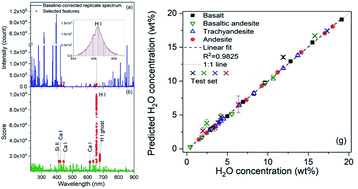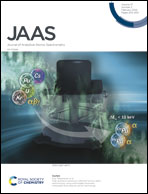Accurate determination of structural H2O in rocks using LIBS coupled with machine learning algorithms extensively exploring the characteristics of the Hα line†
Abstract
The application of laser-induced breakdown spectroscopy (LIBS) in elemental analysis and property assessment of geological materials has been demonstrated to be of great importance and effectiveness. The importance of the application becomes paramount for nonmetal elements, such as hydrogen, since competitive analytical techniques, X-ray fluorescence spectrometry for example, become insensitive to light elements. In particular, a precise determination of structural hydrogen in rocks is highly desired for Mars exploration where LIBS provides a unique technique for quantitative determination of water on a submillimeter scale in geological materials. The task is however challenging because the only reliable Hα line exhibits high excitation energy and high sensitivity to Stark broadening and shift, thus suffering from a heavy matrix effect in a LIBS measurement. The purpose of this work is to substantially improve the determination accuracy of structural water in rocks with an original method to deal with the matrix effect, or more exactly the influences of the bulk chemistry of a rock as well as the form and the concentration of the chemical compounds in rock containing H2O as a constituent. The basic idea is to extensively explore the particular sensitivity of the Hα line to the plasma physical properties for an effective correction of the matrix effect. Research was conducted using both physical and statistical data mining approaches, where the first established the influence of water content on the properties of the induced plasma, while the second, with a multivariate regression based on machine learning algorithms, extracted and appropriately manipulated the suitable information for a significant optimization of H2O determination in rocks. The obtained result of a RMSE of about 0.11 wt% for prediction with independent test samples represents an improvement of an order of magnitude with respect to the previously reported studies.



 Please wait while we load your content...
Please wait while we load your content...